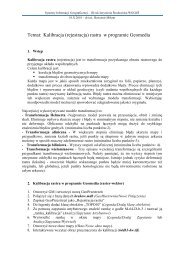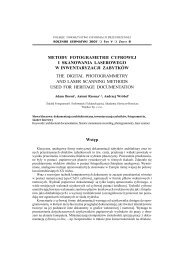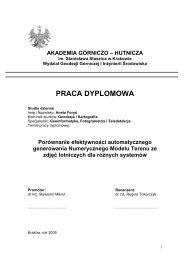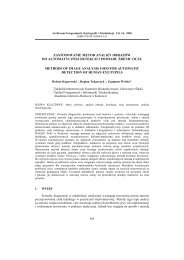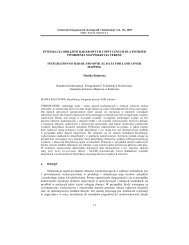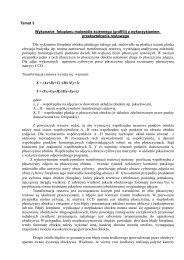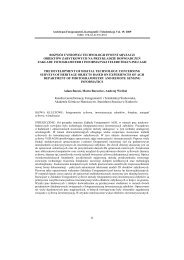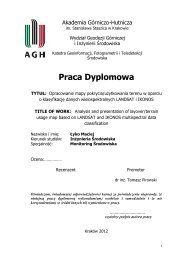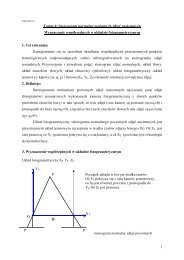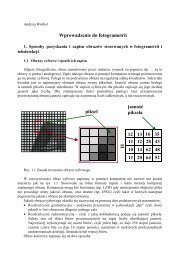Praca Dyplomowa - Photogrammetry and Remote Sensing - AGH
Praca Dyplomowa - Photogrammetry and Remote Sensing - AGH
Praca Dyplomowa - Photogrammetry and Remote Sensing - AGH
You also want an ePaper? Increase the reach of your titles
YUMPU automatically turns print PDFs into web optimized ePapers that Google loves.
THEORETICAL BACKGROUND<br />
photos are processed in a stereo mode – nowadays usually with 3D glasses connected to the<br />
workstation – to see two photos at once in stereo view. These photos are usually used for<br />
making Digital Elevation Model (DEM) <strong>and</strong> orthophotomaps.<br />
2.2.2 Close – range photogrammetry<br />
The camera is located close to the object, h<strong>and</strong>held or on a tripod. Usually this type of<br />
photogrammetry work is non – topographic. It is used usually to model buildings, engineering<br />
structures, vehicles, cultural heritage objects, etc.<br />
To be able to describe an object in 3 dimensions there is a need to be at least two pictures of<br />
the object taken in a proper way. At the beginning of photogrammetry pictures were analogue<br />
<strong>and</strong> specific instruments were used to match pictures <strong>and</strong> use them for map making for<br />
instance. Nowadays everything is computerized <strong>and</strong> there are plenty of cheap, commercial<br />
digital cameras which may be used for this purpose. There are also available metric cameras,<br />
very accurate, with certificates of calibration, made for geodetic measurements. Their<br />
specification is that they have fixed settings like: principle distance, aperture, etc.<br />
Knowing camera parameters <strong>and</strong> location of the cameras, which is computed during camera<br />
orientation (interior, exterior, relative <strong>and</strong> absolute orientation – or in one block during bundle<br />
adjustment), which is mainly to coordinate photos in the space, it is possible to compute 3D<br />
point from triangle – rays intersection (using at least two photos). Figure 2.1 shows this<br />
principle. As these parameters are known, rays may be recreated. After the identification of<br />
common points on each image it is possible to gain the position of this point in 3D space,<br />
which is the intersection of the recreated rays.<br />
Figure 2.1 Photogrammetric principle of 3D measurement; example on convergent image<br />
configuration (Luhmann et al., 2006)<br />
Firstly, the object of interest should be examined, if it is big/small <strong>and</strong>, what kind of features<br />
it contains, etc. In respect to shape of the object, the proper camera with lens (wider angle or<br />
not) should be chosen. If applying lens with wider angle the image scale may be bigger <strong>and</strong><br />
more details may be captured. But, it may also lead to bigger error (distortion etc.) <strong>and</strong> more<br />
photographs needed to cover the entire object.<br />
8




